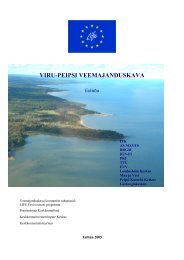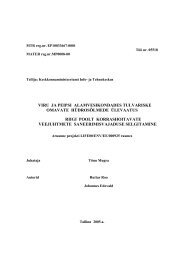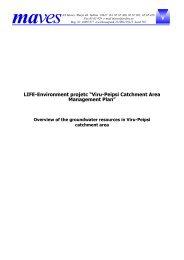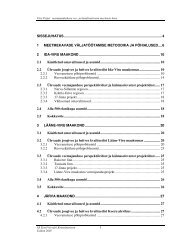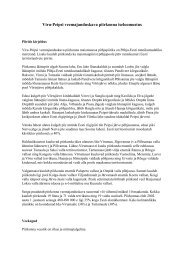open file - Viru Peipsi
open file - Viru Peipsi
open file - Viru Peipsi
Create successful ePaper yourself
Turn your PDF publications into a flip-book with our unique Google optimized e-Paper software.
Climate change scenarios used in modelling of river runoff<br />
MAGICC model and SCENGEN program were applied for climate<br />
change scenario generation in this study. Three alternative greenhouse gas<br />
emission scenarios developed by IPCC (IS92a, IS92c, IS92e) are combined<br />
with results of two general circulation model (GCM) experiences (HadCM2,<br />
ECHAM3TR). As a result, six climate change scenarios up to the year 2100<br />
are prepared for modelling climate change impact on river runoff. The<br />
following abbreviations are used:<br />
HAD - HadCM2 model,<br />
HAM - ECHAM3TR model,<br />
MID - IPCC medium emission scenario (IS92a),<br />
MIN - IPCC minimum emission scenario (IS92c),<br />
MAX - IPCC maximum emission scenario (IS92e).<br />
GCM results are available for 5x5 degree cells. Therefore, the territory of<br />
Estonia is covered by two cells. The border between West and East Estonia<br />
is, in this case, 25°E. The studied watersheds, presented in Table 1, are<br />
located in eastern sector.<br />
In general, results of the both GCMs are quite similar. They project higher<br />
increase of air temperature during the winter half-year (October–March) and<br />
lower increase in the period April–September. Although, the German model<br />
(ECHAM3TR) developed by Max Planck Institute for Meteorology in Hamburg<br />
expects higher warming than the British (Hadley Centre) one – HadCM2. The<br />
increase of air temperature in East Estonia should be higher than in West<br />
Estonia, especially in winter.<br />
Modelling results<br />
Using the WatBal model, changes in river runoff in case of the six climate<br />
scenarios were calculated for all 14 studied river basins. The modelled<br />
changes in annual mean runoff in different basins and scenarios range from<br />
+5% (River Kunda) to +72% (Emajõgi River in station Tartu). Changes in<br />
annual runoff are presented in Table2. The HadCM2 model shows less<br />
increase of runoff while the ECHAM3TR model indicates more increase. The<br />
emission scenarios have rather linear differences. The lowest increase in river<br />
runoff is projected by the HADMIN scenario, the highest one – by HAMMAX.<br />
The highest increase in annual runoff is calculated for Emajõgi River<br />
(catchment area 7840 km 2 ), and also for small river basin Kääpa in not far<br />
from Lake <strong>Peipsi</strong>. In general, an increase of annual runoff by 20–30 per cent<br />
(HADMID) or by 40–50 per cent (HAMMID) are modelled for the year 2100.<br />
These changes can be consider as significant.



